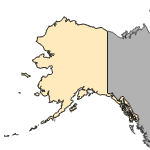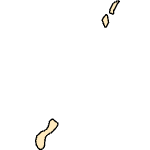Macropodus opercularis
(paradise fish)
Fishes
Exotic |
|
Common name: paradise fish
Synonyms and Other Names: Labrus opercularis, M. chinensis (Bloch, 1790).
Taxonomy: available through
www.itis.gov
Identification: Distinguishing characteristics were given by Sterba (1973) and Masuda et al. (1984). Color photographs of live fish appeared in Masuda et al. (1984) and Axelrod et al. (1985).
Size: 9 cm SL
Native Range: Tropical and temperate Asia. southern China, Taiwan, Indochina, northern Philippines, and Okinawajima of the Japanese Archipelago (Masuda et al. 1984); also reported from Korea and northern (Freyhoff and Herder 2002) and southern Vietnam (Sterba 1973).



|

Alaska |

Hawaii |

Puerto Rico &
Virgin Islands |

Guam Saipan |
Hydrologic Unit Codes (HUCs) Explained
Interactive maps: Point Distribution Maps
Nonindigenous Occurrences:
Unconfirmed report of breeding population in the Everglades, Florida, prior to about 1940 (Myers 1940). Based on extensive sampling during the 1970s, established populations, if ever present, no longer exist (Courtenay and Hensley 1979; Courtenay and Stauffer 1990). Collected in Lake Worth Drainage District canal L-15, west of Atlantis and Lantana, adjacent to a fish farm in Palm Beach County, in 1969 and 1970 (Ogilvie 1969; Courtenay et al. 1974), but species not found in subsequent surveys (Courtenay and Hensley 1979a). Several specimens were taken from a marsh in Orleans Parish, Louisiana, in March 1997 (Cashner, personal communication).
Table 1. States with nonindigenous occurrences, the earliest and latest observations in each state, and the tally and names of HUCs with observations†. Names and dates are hyperlinked to their relevant specimen records. The list of references for all nonindigenous occurrences of Macropodus opercularis are found here.
Table last updated 12/17/2025
† Populations may not be currently present.
Means of Introduction: The Florida records probably result of aquarium releases or escapes from fish farms. Louisiana records are probably aquarium releases.
Status: There is no recent evidence of a breeding population in the Florida Everglades; more recent reports of fish represent non-established populations (Courtenay and Hensley 1979; Courtenay and Stauffer 1990). Reported from Louisiana but status is uncertain.
Impact of Introduction: The impacts of this species are currently unknown, as no studies have been done to determine how it has affected ecosystems in the invaded range. The absence of data does not equate to lack of effects. It does, however, mean that research is required to evaluate effects before conclusions can be made.
References: (click for full references)
Axelrod, H.R., W.E. Burgess, N. Pronek, and J. G. Walls. 1985. Dr. Axelrod's atlas of freshwater aquarium fishes. Tropical Fish Hobbyist Publications, Inc., Neptune City, NJ.
Courtenay, W.R., Jr., and D.A. Hensley. 1979. Survey of introduced non-native fishes. Phase I Report. Introduced exotic fishes in North America: status 1979. Report Submitted to National Fishery Research Laboratory, U.S. Fish and Wildlife Service, Gainesville, FL.
Courtenay, W.R., Jr., and J.R. Stauffer, Jr. 1990. The introduced fish problem and the aquarium fish industry. Journal of the World Aquaculture Society 21(3):145-159.
Courtenay, W.R., Jr., H.F. Sahlman, W.W. Miley, II, and D.J. Herrema. 1974. Exotic fishes in fresh and brackish waters of Florida. Biological Conservation 6(4):292-302.
Freyhof, J., and F. Herder. 2002. Review of the paradise fishes of the genus Macropodus in Vietnam, with description of two species from Vietnam and southern China (Perciformes: Osphronemidae). Ichthyological Exploration of Freshwaters 13(2):147-167.
Masuda, H., K. Amaoka, C. Araga, T. Uyeno, and T. Yoshino, editors. 1984. The fishes of the Japanese Archipelago. Tokai University Press.
Myers, G.S. 1940. An American cyprinodont fish, Jordanella floridae, reported from Borneo, with notes on the possible widespread introduction of foreign aquarium fishes. Copeia 1940:267-268.
Sterba, G. 1973. Freshwater fishes of the world. English translation and revision from German. Two volumes. Tropical Fish Hobbyist Publications, Inc., Neptune City, NJ.
FishBase Summary
Author:
Nico, L.
Revision Date: 4/30/2018
Peer Review Date: 6/12/2012
Citation Information:
Nico, L., 2025, Macropodus opercularis (Linnaeus, 1758): U.S. Geological Survey, Nonindigenous Aquatic Species Database, Gainesville, FL, https://nas.er.usgs.gov/queries/FactSheet.aspx?speciesID=330, Revision Date: 4/30/2018, Peer Review Date: 6/12/2012, Access Date: 12/18/2025
This information is preliminary or provisional and is subject to revision. It is being provided to meet the need for timely best science. The information has not received final approval by the U.S. Geological Survey (USGS) and is provided on the condition that neither the USGS nor the U.S. Government shall be held liable for any damages resulting from the authorized or unauthorized use of the information.